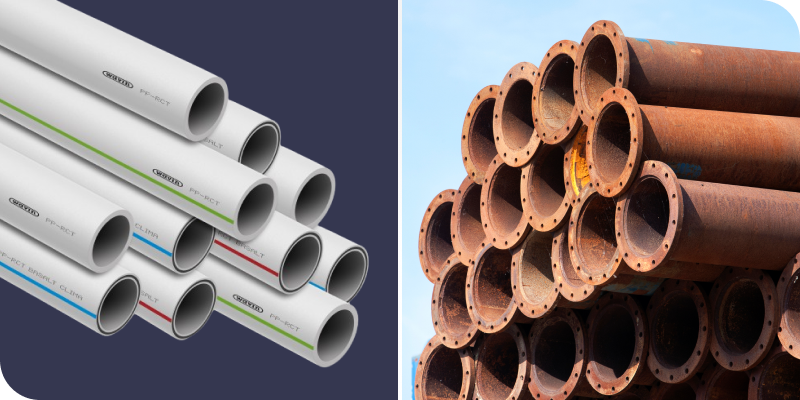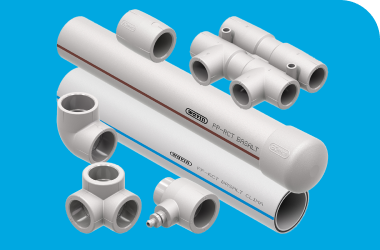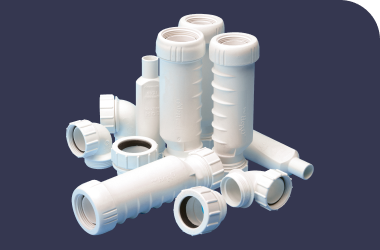
- Common Types of Metal and Plastic Pipe Used in Commercial Buildings
- Advantages of Plastic Pipe in Commercial Buildings
- Plastic vs. Metal for Commercial Applications
- Lifecycle Environmental Impact of Plastic Pipe vs. Metal Pipe
- Advantages of Wavin Plastic Piping
The North American plumbing industry debate about metal piping versus plastic piping comes down to a question of durability. While metal piping such as steel, copper and cast iron is capable of withstanding extreme temperatures and pressure, they can be harder to install and don’t always have the same long lifespan as plastic pipes.
Plastic pipes such as polyvinyl chloride (PVC), chlorinated polyvinyl chloride (CPVC) and cross-linked polyethylene (PEX) are ideal materials for plumbing applications because they are corrosion-resistant, non-reactive, have low heat conductivity, and are easy to install.
Plastic piping is considered environmentally responsible and sustainable, as it can be recycled and has a long lifespan — an important consideration as our planet deals with the consequences of climate change.
“PVC pipe manufacturing is extremely efficient, with virtually 100 percent of the PVC compound being used,” notes the Uni-Bell PVC Pipe Association (PVCPA). “The product is completely recyclable, making its environmental footprint far smaller than competing piping materials. [Its] ultra-smooth surface reduces pumping costs, and its leak-free joints eliminate water loss.”
Durability and corrosion resistance are PVC pipe’s best eco-friendly attributes, the PVCPA adds, “leading to better water conservation and lower replacement, maintenance and repair costs.”
The PVCPA published the first North American industry-wide environmental product declaration for water and sewer piping, concluding that PVC has a life expectancy of more than 100 years. ”Its light weight and ease of installation reduce transportation and installation costs, yielding further benefits to the environment,” the association notes.
PEX pipe also has eco-friendly attributes, Green Building & Design magazine notes: “It has lower environmental impacts during manufacturing compared to copper because it reduces manufacturing, transportation, and disposal burdens. Plus, the energy consumed and overall impacts from manufacturing PEX pipe using common, low-temperature extrusion processes is a clean, low-impact operation.”
Similar to metal piping, PEX is estimated to last 50-plus years when installed and maintained properly.
Common Types of Metal and Plastic Pipe Used in Commercial Buildings
Cast iron. The weight of cast-iron pipe relegates it to commercial water distribution systems and sewer lines. It can deliver large amounts of water under heavy pressure and is fire-resistant.
Stainless steel. While higher in price than other piping materials, durable stainless steel is ideal when corrosion is an issue.
Copper. Also having a high price tag — and a high target for thieves — copper is a versatile metal used in hot and cold water systems and handles refrigerants well.
PVC. PVC pipe is a durable, cost-effective alternative to metal piping. It is best suited to indoor or drainage applications because of its low UV resistance.
Wavin’s Schedule 40 PVC pipe and fittings, frequently used in water supply systems for human consumption, are specially designed for water conduction at room temperature under pressure for domestic and industrial use.
CPVC. This piping is primarily used for potable water applications because of its added chlorine.
Bow FlowGuard Gold CPVC from Wavin is a high-temperature pressure piping system for potable plumbing. It is corrosion-resistant to chlorine and other common disinfectants in municipal water systems.
PEX. This flexible piping is used in indoor and outdoor applications and can tolerate temperature changes of hot and cold water — a good choice for a commercial building’s water distribution system.
Wavin’s chlorine-resistant SuperPEX multi-layer pipe has a patented design, offering the highest protection against UV rays prior to installation. It can also be used as a water service pipe buried underground outside of a building.
PP-R/PP-RCT. The newest high-temperature plastic piping is used for domestic hot and cold potable water for residential and commercial plumbing, chilled water and condensed water for cooling towers, data centers and supercomputers, reclaimed water collection and distribution, and hydronic heating and cooling systems. Its heat-fused joints make the piping nearly leak-proof.
Wavin PP-RCT includes a basalt fiber layer, using innovative materials for a real advantage. The piping has reduced thermal expansion, is impact-resistant, delivers higher-pressure performance, achieves high-temperature resistance, and delivers a better flow thanks to the significantly increased inner bore.
Advantages of Plastic Pipe in Commercial Buildings
Plastic pipe has been used in residential applications for many years, but many engineers, contractors, and building owners have moved to plastic piping in large-scale commercial projects as it reduces material and labor costs while providing durability.
Cost-effectiveness and economic considerations
PVC piping’s cost-effectiveness versus metal piping includes installation, maintenance, purchasing, and dismantling costs, notes ForConstructionPros.com.
With PEX piping, installation is much quicker than metal piping and requires fewer fittings, reducing labor costs. The flexibility of the piping makes it resistant to freeze damage and corrosion, giving it high durability. Also, its insulation properties reduce heat loss in hot water systems and conserve energy.
Lightweight in nature, making them easier to handle and install
Strong, lightweight PVC is easy to bond using solvents or adhesives, ForConstructionPros.com explains: “Its resistance to abrasion, natural mechanical strength, toughness, and light weight are just some of the features that make PVC ideal for many building and construction applications.”
The flexibility of PEX pipe allows for installation in tight spaces or around obstructions without cutting and soldering, reducing the number of required joints, leaking, and failure points.
Durability, longevity, and heat resistance
As noted previously, PVC pipe has been shown to last 100-plus years for underground piping, while PEX has a lifespan of about 50 years.
Plastic piping’s low thermal conductivity means it can better maintain the temperature of transported water, whether hot or cold.
PEX provides improved efficiency in hot water applications, which is why it has been used in radiant heating applications for many years.
Plastic vs. Metal for Commercial Applications
Using plastic or metal pipe for commercial plumbing depends on the application, so it’s wise to weigh the pros and cons of each material.
However, more plumbing professionals are using plastic piping in commercial plumbing for its durability (not subject to cracks or rusting), low risk of contamination, resistance to corrosion abrasion and high pressures, and sustainability/recyclability.
Metal piping can be problematic when carrying water because it is prone to corrosion and rust. Insulation and protective coating can alleviate the issue but adds to material costs.
Alternatively, plastic pipe is a good choice for cold water lines as it is less expensive than metal pipe and resistant to corrosion. It’s easier to work with and customizable — manufacturers offer a variety of sizes and fittings for water systems. And it’s safer as it does not require any brazing or welding, helping to keep the jobsite fire-free.
In some applications, metal pipe is often a better choice for hot water lines, as it can withstand higher temperatures and pressures. However, plastic pipe eliminates the water hammer typically found in metal water piping systems. Plastic’s resistance to corrosion and chemicals makes it a good choice for drain, waste, and vent applications.
In addition, plastic and metal piping can be used together to help reduce the cost of the plumbing system. PEX can be connected to existing water supply lines such as copper and stainless steel with the correct fittings, making it a versatile material for retrofits.
In medical settings, PVC pipe is a good choice because it can withstand high temperatures: “With the proper additives, PVC is able to withstand temperatures of up to 250° F, which allows it to be sterilized using steam. One unique attribute of PVC is that it can be formulated with additives that give it antimicrobial properties. Once active ingredients, such as silver, are infused into the formula, the resulting product can resist harmful bacteria, mold, fungi, and viruses by up to 99.99%.”
PEX piping is touted as a safer alternative to metal piping in schools, notes Plumber magazine: “One of the best features of PEX is its durability. While copper systems can corrode and experience scale buildup over time, PEX is immune to corrosion and scale buildup — factors that can affect water quality in the form of bad taste and odor or even bacterial formation.
“In addition, PEX joining methods don’t require glues, cements, or other chemicals that are necessary with CPVC systems. These joining chemicals have the potential to pose a risk if they seep into the drinking water system.”
Finally, using plastic pipe for water distribution systems can help alleviate the skilled labor shortage prevalent in the U.S. plumbing industry: easy-to-install systems make it easier to train new recruits in the trade.
Lifecycle Environmental Impact of Plastic Pipe vs. Metal Pipe
“Plastic piping systems have a variety of attributes that make them the sustainable and environmentally responsible choice,” explains the Plastics Pipe Institute. “A low carbon footprint, lightweight and fuel-efficient shipping, safe inert raw materials, long service life, and recyclability are among the many features and benefits that make a plastic piping system the preferential choice.”
A life cycle assessment (LCA) is used to quantify the potential environmental impacts of products. The PVCPA conducted an LCA on PVC pipe; you can find the results here.
“The LCA and research conducted for this study show that PVC has lower environmental impacts from a life cycle and carbon footprint perspective — lower embodied energy, lower use-phase energy, and longer life attributes compared to other pipe materials,” the report states.
You can find a PEX LCA here; it finds definite advantages for PEX in hot and cold water distribution.
An LCA of the economic and environmental performances of PEX and copper piping on a student housing project found that “using PEX instead of copper piping systems would considerably reduce the total cost of the building up to 63% over its life cycle while reducing the carbon dioxide emissions by approximately 42% and lessening the negative effect of environmental impacts to land, water, and air,” according to Green Building & Design magazine.
Plastic pipe manufacturer Wavin is committed to net-zero carbon emissions by 2050, eliminating virgin plastic from packaging (most already used 30% recycled material), recycling and reducing materials used to minimize environmental impact, and developing solutions for the lack of clean water and sanitation worldwide.
Advantages of Wavin Plastic Piping
Wavin’s plastic pipes — PVC, CPVC, PEX, and PP-RCT— are used in commercial building projects all over the world. They are lightweight, easy-to-install alternatives to metal piping, reducing material and labor costs. Corrosion resistance makes the piping materials ideal for many water distribution applications.
Wavin SuperPEX. This multilayer pipe makes installation simple and worry-free in industrial, commercial, high-rise, and multifamily residential facilities. Extremely resistant to chlorine (highest rated in chlorine resistance) in most demanding conditions such as hot water domestic continuous recirculation.
With two layers of defense, it is rated for 180 days of UV resistance (highest UV resistance rating), compared to standard PEXpipe with 30 days maximum exposure.
Wavin Bow FlowGuard® Gold CPVC. This high-temperature pressure piping for potable plumbing is designed for residential/commercial hot and cold water pressure applications. It is the only complete CPVC pipe and fittings system made from materials that are pressure-rated by the Plastic Pipe Institute. Features up to 92% higher sustained pressure resistance at elevated temperature, up to 80% higher resistance to impact fracture, and fittings last up to four times longer at elevated temperatures and pressures.
Manufactured with high durability and impact resistance, it is corrosion-resistant to chlorine and other common disinfectants used in municipal water systems. It is rated for the highest chlorine and UV resistance.
Wavin Schedule 40 PVC. This piping is typically used for transporting potable water. However, it is also used for distributing other pressurized liquids, provided they are chemically compatible with PVC. It is intended for places where the liquid temperature does not exceed 140° F, such as residential buildings, high-rise buildings, offices, commercial buildings, hospitals, hotels, and semi-industrial environments.
It is resistant to oxidation and corrosion, non-toxic and odorless, has smooth interior walls with low frictional loss, is lightweight, and easy to install using solvent weld.
Wavin PP-RCT Basalt. The basalt fiber in the middle layer ensures a better-performing, lightweight pipe with high corrosion resistance; it is more environmentally friendly compared to metal piping and glass fiber-filled polymer alternatives; it can be used in a wide range of high-pressure applications; and offers low-lead fittings.




.png?width=380&height=250&name=wavin-us-pprct%201%20(1).png)
